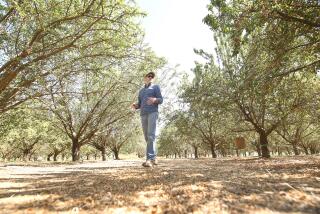A Paradise for Pests : Health: Long days, soggy ground and robust plant growth add up to perfect conditions for insects. Some just annoy, others pose dangers.
Stagnant pools and soppy grounds left from the winter’s heavy rainfall are turning Ventura County springtime into an insect paradise.
As the days get longer and the air gets warmer, entomologists say, conditions are right for mosquitoes, flies and fleas to thrive, threatening the peace of mind, and in some cases the health, of residents.
“We’re going to find a lot of insects enjoying all the growth we’re getting from all the rain,” said Ventura arborist Jerry Revard. “We’ll probably see an explosion of certain populations.”
While most insects are merely unwelcome, ticks, fleas and mosquitoes have brought encephalitis, Lyme disease and bubonic plague to the area in recent years. No cases of the insect-carried diseases have been reported in the county this year.
But bug season has just begun.
Like the groundhog’s shadow forecasting spring weather in snowier climes, swarms of crane flies have descended on the county, the harbingers of a pest-infested summer.
The large, winged insects, also known as mosquito hawks, hatch and cluster near damp, woody areas, said Tom Atkinson, an entomologist at UC Riverside. Contrary to popular belief, he said, they do not eat mosquitoes.
“Crane files don’t do anything,” Atkinson said. “They don’t bite, they don’t sting, they don’t buzz, they don’t get in your food. Eventually they just die and fall onto the window ledge.”
By the time crane fly season ends this month, mosquitoes should be out in full force, said Bob Gallagher, manager of the county’s mosquito abatement program.
“We’re getting ready for a pretty big year,” Gallagher said.
In high season, as many as seven vector control technicians hit 500 targeted spots countywide, looking for larvae and spraying a thin layer of oil onto hotbeds of mosquito growth. Or they release mosquito-eating minnows or spread a poisonous Grape Nut-like bacteria called Bacillus thuringiensis .
“If we were to let these places go, there would be tens of thousands of mosquitoes coming out,” said vector control technician Dan McCann.
Mosquitoes can carry diseases, including encephalitis, which was first found in the county last fall in chickens in Thousand Oaks. The disease, which causes swelling of the brain, is untreatable and sometimes fatal. Two cases of encephalitis were reported in California in 1992.
By keeping mosquito numbers down, the abatement program helps decrease the risk of disease, McCann said. A new tax on property owners was recently approved by the county Board of Supervisors to pay for the $303,000 program, which lost most of its state funding this year.
The program also monitors ticks, which carry Lyme disease, an illness that causes sore joints and in some cases arthritis. Ventura’s first case of the disease was reported in 1991.
On a recent morning, McCann hiked through the trails at Arroyo Verdo Park, collecting ticks on a light blue flannel flag that he waved over path bushes.
“The worst of the tick season is right about now, while the air is still cool,” McCann said, popping a tick into a small glass vial. “They get on the ends of the grasses and sit with their legs in the air, waiting for something to come by that they can grab onto.”
And grab they do.
“I was out over the weekend, and when I got back I was just covered in ticks,” said hiker Jeanie Morgan. “It’s gross. I’ll be glad when the season is over.”
But tick season never really ends, McCann said. Under the right conditions, “they can live for years,” he said.
“They need a blood meal to lay eggs, but they can go months without eating and they are hard to kill.”
Fleas, which reproduce in abundance during warmer months, are equally hardy, McCann said.
“My dog has always had them, and right about now is when it starts getting bad,” Sheila Moore said as her Dalmatian scratched behind his left ear. “Sometimes they bite me too, but I guess that’s just part of having a dog.”
In addition to pestering owners and pets, fleas can carry diseases such as bubonic plague, which causes high fever, nausea and, if not treated quickly, death. Last summer health officials found plague-infected rodents in Frazier Park on the border between Ventura and Kern counties.
Germ-carrying flies, which are generally less threatening but more irritating than other bugs, are also expected to be out in large numbers, said Leta Yancy, executive secretary of the Moorpark Mosquito Abatement District.
Fortunately, the abatement program is equipped to handle the deluge, Yancy said. Moorpark is the only city in the county with its own program, which Yancy said was set up 33 years ago because of a serious fly problem caused by neighboring chicken ranches.
“They just hover,” she said. “They get under your porch or patio cover and they won’t budge.” Before the abatement program, “ladies who put their laundry on the line would have to take them down and rewash them. It was a terrible nuisance.”
FYI: County Environmental Health Division tips to avoid mosquito infestations include emptying any outdoor containers holding water, tightly covering swimming pools when they are not in use, and stocking fish ponds with mosquito-eating fish. If a problem persists, call the county mosquito abatement program at 654-2813.
More to Read
Sign up for Essential California
The most important California stories and recommendations in your inbox every morning.
You may occasionally receive promotional content from the Los Angeles Times.










